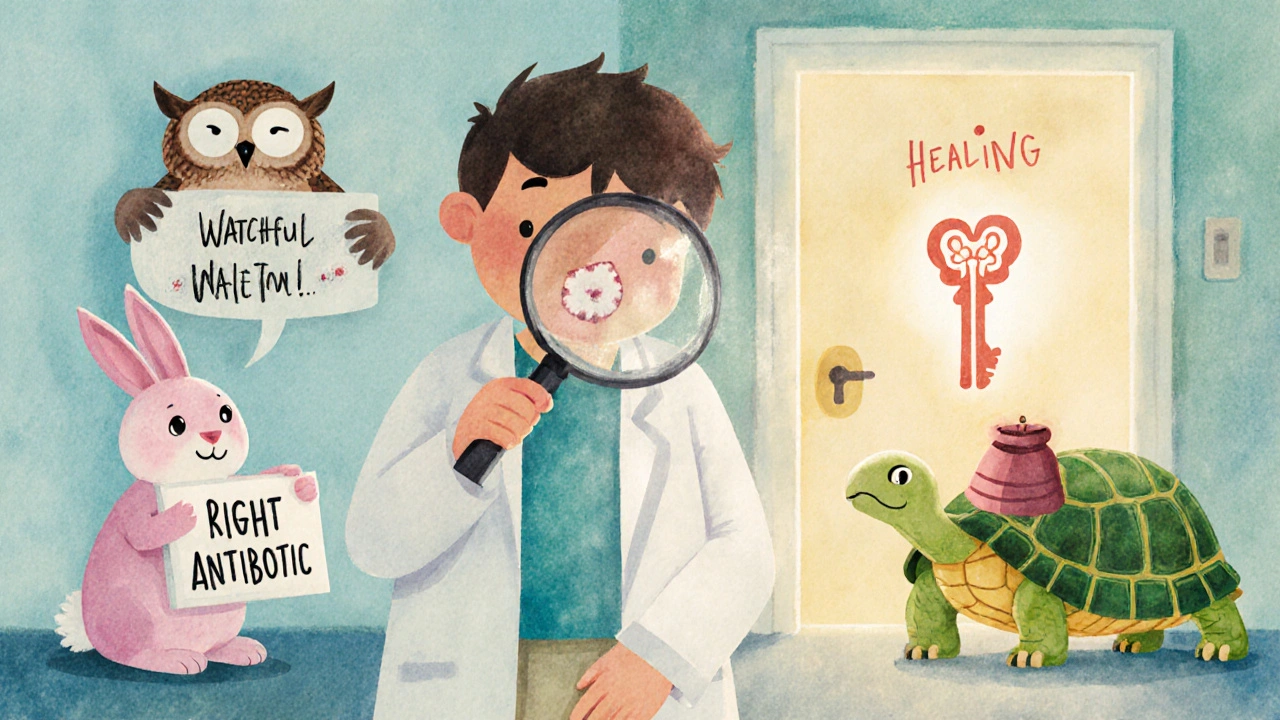Antibiotic Selector: Which Antibiotic is Right for Your Infection?
Find Your Best Antibiotic Option
Answer a few questions to determine the most appropriate antibiotic for your situation based on current clinical guidelines and patient safety.
If you’ve been prescribed Keflex (cephalexin) for a skin infection, sinusitis, or urinary tract infection, you’re not alone. It’s one of the most commonly used antibiotics in the U.S. and Australia. But you might be wondering: Is Keflex the best choice for me? Or could another antibiotic work better with fewer side effects or lower cost?
Not all antibiotics are created equal. What works for your neighbor’s ear infection might not be right for your case. Doctors often pick Keflex because it’s broad-spectrum, affordable, and well-tolerated. But there are plenty of alternatives - some just as effective, others better suited for specific infections or allergies. Let’s break down the real differences between Keflex and its top alternatives, based on clinical guidelines, patient experiences, and current prescribing trends in 2025.
What is Keflex (Cephalexin)?
Keflex is the brand name for cephalexin, a first-generation cephalosporin antibiotic that kills bacteria by disrupting their cell walls. It’s been around since the 1960s and is still widely used today because it’s effective against common skin and soft tissue infections, like cellulitis and impetigo, as well as some respiratory and urinary tract infections.
It comes in capsules, tablets, and liquid form. Most people take it two to four times a day for 7 to 14 days. It’s usually well-tolerated, but side effects like diarrhea, nausea, and stomach upset happen in about 1 in 10 users. Rarely, it can cause allergic reactions - especially in people allergic to penicillin.
One big advantage? Keflex is cheap. In Australia, a 10-day course of 500mg capsules costs under $15 with a PBS subsidy. That makes it a go-to for GPs when they need something reliable and budget-friendly.
Common Alternatives to Keflex
Doctors reach for different antibiotics depending on the infection type, patient history, and local resistance patterns. Here are the top five alternatives you’re likely to hear about.
Amoxicillin
Amoxicillin is a penicillin-class antibiotic, often sold as Amoxil or generic versions. It’s one of the most common alternatives to Keflex, especially for ear infections, strep throat, and sinus infections.
Unlike Keflex, amoxicillin is more active against certain Gram-positive bacteria like Streptococcus pneumoniae - the usual culprit in ear and sinus infections. Studies from the Australian Therapeutic Guidelines show it’s slightly more effective than cephalexin for acute otitis media in children.
But here’s the catch: if you’re allergic to penicillin, you can’t take amoxicillin. About 10% of people who think they’re allergic to penicillin actually aren’t - but unless you’ve been tested, it’s safer to avoid it. Also, amoxicillin can cause more diarrhea than Keflex, especially in kids.
Clindamycin
Clindamycin is a go-to when Keflex fails or when the infection is caused by MRSA (methicillin-resistant Staphylococcus aureus). It’s often prescribed for deep skin abscesses, especially if there’s pus or if the patient has a history of recurrent staph infections.
Clindamycin works differently - it stops bacteria from making proteins instead of breaking their cell walls. That makes it useful when bacteria have developed resistance to cephalosporins. It’s also effective against anaerobic bacteria, which Keflex doesn’t touch well.
But clindamycin comes with a serious risk: C. diff colitis. About 1 in 100 people who take it develop severe diarrhea from this antibiotic-associated infection. That’s why doctors don’t use it as a first-line treatment unless they have a good reason.
Doxycycline
Doxycycline is a tetracycline antibiotic, often used for acne, tick-borne illnesses like Lyme disease, and some respiratory infections. It’s not a direct replacement for Keflex in skin infections, but it’s become a popular alternative for patients with penicillin or cephalosporin allergies.
Doxycycline is especially useful if you’re dealing with a bite-related infection - like from a spider or tick - or if your infection involves unusual bacteria like Mycoplasma or Chlamydia. It’s also used for rosacea and some types of pneumonia.
Side effects? It can cause severe sunburn, so you need to avoid direct sunlight. It also shouldn’t be taken by kids under 8 or pregnant women because it can stain developing teeth. And it needs to be taken on an empty stomach - no dairy, antacids, or iron supplements within two hours.
Ciprofloxacin (Cipro)
Ciprofloxacin is a fluoroquinolone antibiotic. It’s much stronger than Keflex and used for more serious infections - like complicated UTIs, kidney infections, or bone infections.
While Keflex covers many common bacteria, ciprofloxacin hits a broader range, including Pseudomonas and E. coli strains that are resistant to older antibiotics. That’s why it’s often used in hospitals or for patients with recurrent UTIs.
But it’s not a first-choice for simple infections. The FDA has issued black box warnings for fluoroquinolones because of risks like tendon rupture, nerve damage, and aortic aneurysm. In Australia, the TGA restricts their use to cases where no other option works. If your infection is mild, ciprofloxacin is overkill - and potentially risky.
Trimethoprim
Trimethoprim (often combined with sulfamethoxazole as Bactrim or Septra) is a common alternative for urinary tract infections. It’s not used for skin infections, but for uncomplicated UTIs, it’s just as effective as Keflex - and cheaper in many cases.
Trimethoprim works by blocking bacterial folate production. It’s especially good against E. coli, which causes 80% of UTIs. In Australian GP clinics, trimethoprim is often the first choice for simple cystitis in women.
Side effects include rash, nausea, and, rarely, low blood cell counts. People with kidney disease or G6PD deficiency need to be careful. Also, it’s not recommended if you’re pregnant in the first trimester.
Comparison Table: Keflex vs. Top Alternatives
| Antibiotic | Best For | Typical Dosage | Common Side Effects | Key Risks | Cost (10-day course, AUD) |
|---|---|---|---|---|---|
| Keflex (Cephalexin) | Skin infections, mild UTIs, sinusitis | 250-500mg every 6-12 hours | Diarrhea, nausea, stomach upset | Allergic reaction (if penicillin-allergic) | $12-$18 |
| Amoxicillin | Ear infections, strep throat, sinusitis | 500mg every 8 hours | Diarrhea, rash, yeast infection | Penicillin allergy (cross-reactivity) | $10-$15 |
| Clindamycin | MRSA skin infections, abscesses | 300-450mg every 6-8 hours | Severe diarrhea, vomiting | C. diff colitis (1 in 100) | $25-$40 |
| Doxycycline | Acne, Lyme disease, tick bites | 100mg twice daily | Sun sensitivity, upset stomach | Tooth discoloration (under 8), esophageal irritation | $18-$25 |
| Ciprofloxacin | Complicated UTIs, kidney infections | 500mg every 12 hours | Nausea, dizziness, tendon pain | Tendon rupture, nerve damage | $35-$50 |
| Trimethoprim | Uncomplicated UTIs | 300mg once daily | Rash, headache, nausea | Blood cell issues, not for first-trimester pregnancy | $8-$12 |
When Should You Avoid Keflex?
You might need a different antibiotic if any of these apply to you:
- You’ve had a serious allergic reaction to penicillin - Keflex has a 5-10% cross-reactivity risk.
- Your infection isn’t improving after 3 days - it could be caused by MRSA or a resistant strain.
- You’re pregnant or breastfeeding - while Keflex is generally considered safe, some alternatives like nitrofurantoin or cefdinir are preferred for UTIs.
- You’re over 65 or have kidney disease - Keflex is cleared by the kidneys, so dosage needs adjustment.
- You’ve had C. diff before - any antibiotic can trigger a recurrence, but clindamycin and fluoroquinolones are especially risky.
What Do Doctors Actually Recommend?
In 2025, Australian and U.S. guidelines agree on one thing: don’t overprescribe antibiotics. The World Health Organization lists cephalexin as a WHO Essential Medicine, but only for appropriate cases.
Most GPs now follow a "watchful waiting" approach for mild sinus or ear infections. If symptoms don’t improve in 48-72 hours, they’ll start an antibiotic - and often choose amoxicillin or trimethoprim over Keflex, depending on the infection.
For skin infections, Keflex is still first-line - unless the patient has a history of MRSA. In those cases, clindamycin or doxycycline are preferred. For UTIs, trimethoprim is the default unless resistance rates in the area are high (over 20%), then cephalexin or nitrofurantoin are used.
Bottom line: Keflex isn’t "better" - it’s just the right tool for the right job.

What to Do If You’re Unsure
If you’ve been given Keflex and you’re wondering if another option would be better, don’t switch on your own. Antibiotic resistance is rising, and taking the wrong one can make things worse.
Instead:
- Ask your doctor: "Is this the best choice for my type of infection?"
- Ask: "Are there alternatives if I have allergies or side effects?"
- Ask: "What signs should I watch for that mean I need to come back?"
Many people feel embarrassed asking these questions - but doctors expect them. The right antibiotic saves time, money, and avoids complications.
Frequently Asked Questions
Can I take Keflex if I’m allergic to penicillin?
About 5-10% of people allergic to penicillin will also react to Keflex because they’re both beta-lactam antibiotics. If you had a severe reaction like anaphylaxis or swelling of the throat, avoid Keflex. For mild rashes, some doctors may still prescribe it after a careful risk-benefit discussion. Always tell your doctor your full allergy history.
Is Keflex better than amoxicillin for a sinus infection?
For most sinus infections, amoxicillin is actually preferred because it’s more effective against the common bacteria involved, like Streptococcus pneumoniae. Keflex works too, but studies show slightly lower cure rates. If you’re allergic to penicillin, Keflex is a good alternative. Otherwise, amoxicillin is the first-line choice.
How long does it take for Keflex to work?
Most people start feeling better within 2-3 days. But you need to finish the full course - even if you feel fine. Stopping early can leave behind the strongest bacteria, which then multiply and cause a worse, resistant infection. If you don’t feel any improvement after 3 days, call your doctor.
Can I drink alcohol while taking Keflex?
Yes, alcohol doesn’t interact with Keflex. Unlike metronidazole or some other antibiotics, it won’t make you sick if you drink. But alcohol can dehydrate you and weaken your immune system, which might slow healing. It’s best to avoid it while you’re fighting an infection.
Are there natural alternatives to Keflex?
No. While garlic, honey, and tea tree oil have some antibacterial properties in lab studies, none are proven to treat bacterial infections like cellulitis, UTIs, or pneumonia in humans. Relying on natural remedies instead of antibiotics can lead to serious complications - including sepsis. Always use prescribed antibiotics for confirmed bacterial infections.
Next Steps
If you’re on Keflex and doing well, keep taking it. Don’t stop early. If you’re having side effects or it’s not working, contact your doctor. Don’t switch to another antibiotic without medical advice.
If you’ve been prescribed Keflex and you’re unsure why - ask. Understanding your treatment helps you take it correctly and avoid unnecessary risks. Your body doesn’t respond the same way as your neighbor’s. The right antibiotic is the one that matches your infection, your history, and your body - not the cheapest or most popular one.



Comments (15)
Derron Vanderpoel
i just took keflex for a bad pimple infection and it worked like magic. my skin cleared up in 3 days. no drama, no side effects. why overcomplicate it? sometimes the old-school stuff just works.
Michael Salmon
Oh wow, another post glorifying Keflex like it’s the holy grail of antibiotics. Let me guess - you also think penicillin was invented by angels and clindamycin is the devil’s cough syrup? The real issue is that doctors prescribe like they’re playing bingo with drug samples. Most infections resolve on their own. Antibiotics are overused, misused, and monetized. And now we’ve got superbugs dancing in the ICU because people like you think ‘cheap and common’ equals ‘best.’
Christopher Robinson
Really appreciate this breakdown 🙏 I had a UTI last year and my doc pushed Keflex, but I asked about trimethoprim - turns out it’s cheaper AND more effective for my strain. Also, side note: doxycycline ruined my skin for a week because I forgot about the sun thing 😅 Don’t be me. Read the fine print.
Christopher K
Of course Keflex is the best - it’s American-made, not some imported junk from India or Canada. Why are we letting our GPs prescribe trimethoprim like it’s a hipster coffee blend? We’ve got world-class pharma here. Stick to what works: Keflex, made in the USA, tested by real doctors, not Reddit armchair microbiologists.
harenee hanapi
Oh my god I had such a bad reaction to clindamycin last year… I was in the ER for 12 hours with C. diff. I still have nightmares about the diarrhea. I swear I’m never taking another antibiotic unless I’m literally dying. My mom says I’m too sensitive but she doesn’t understand what it’s like to lose your dignity like that… I just want to be heard.
Marjorie Antoniou
Thank you for writing this. So many people don’t realize antibiotics aren’t one-size-fits-all. I’m allergic to penicillin and was terrified to take Keflex - but my doctor walked me through the cross-reactivity stats and we decided it was safe. Knowledge is power. Seriously.
Frank Dahlmeyer
Let me tell you something - I’ve been a paramedic for 22 years, and I’ve seen people come in with cellulitis so bad their leg looked like a boiled lobster. Keflex saved their lives. Not because it’s fancy, not because it’s expensive - because it’s reliable. People forget that medicine isn’t about trends or influencers or ‘alternatives.’ It’s about what kills the bacteria before it kills you. And Keflex? It’s been doing that for 60 years. Don’t let the ‘natural remedies’ crowd convince you otherwise - your body doesn’t care about your Instagram bio.
Codie Wagers
The entire premise of this post is a fallacy. There is no ‘best’ antibiotic. There is only the right antibiotic for the right host, the right pathogen, the right ecological context. To reduce complex microbial ecology to a cost-per-dose spreadsheet is not medical insight - it’s commodification disguised as pragmatism. Keflex is not a hero. It is a tool. And like any tool, its moral weight is determined by the hands that wield it - and the ignorance that chooses to use it.
Paige Lund
So… Keflex is cheap. Cool. So’s duct tape. Doesn’t mean I should fix my car with it.
Reema Al-Zaheri
Trimethoprim is not just ‘cheaper’-it’s pharmacokinetically superior for uncomplicated UTIs due to its renal concentration profile and lower resistance rates in community strains. The 2024 UK NICE guidelines explicitly recommend it as first-line, and the Australian Therapeutic Guidelines concur. Keflex is appropriate for skin infections, but for cystitis? It’s outdated. Why is this still being debated?
Joe Durham
My niece had MRSA on her arm - Keflex did nothing. Clindamycin fixed it in 48 hours. But then she got the C. diff nightmare. We were scared to death. My point? There’s no perfect drug. It’s always a trade-off. Just make sure your doctor knows your full history - allergies, past infections, even your travel history. It matters.
Nick Lesieur
Wow this is the most boring post ever. Like who cares? Just take the pill and shut up. Also, ‘natural alternatives’? Lol. You think garlic is gonna save you from sepsis? Go drink some honey and call me when you’re dead.
Angela Gutschwager
Just finished Keflex. Felt fine after day 2. Didn’t finish the full course. 😇
Timothy Reed
Thank you for this comprehensive and well-researched overview. It’s refreshing to see a post that doesn’t oversimplify antibiotic selection. The comparison table is especially helpful for patients who want to understand their options. I’d only add one note: when discussing allergies, it’s worth emphasizing that many people self-diagnose penicillin allergy based on childhood rashes - and that formal testing can open up safer, more effective options. This kind of education reduces unnecessary restrictions and improves outcomes.
James Ó Nuanáin
While the data presented is largely accurate, one must acknowledge the systemic erosion of clinical autonomy in the United States, where formularies are dictated by corporate pharmacy benefit managers rather than medical evidence. In the UK, we still retain the right to prescribe based on individual patient needs - not cost-per-dose metrics. Keflex remains a viable option in our NHS protocols, but only when clinical judgment dictates - not when the spreadsheet demands it. One must question: who truly benefits from the commodification of antibiotics? Not the patient. Not the physician. Only the shareholders.